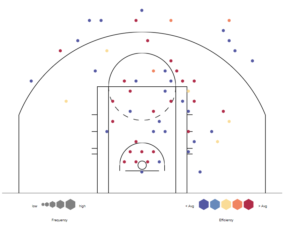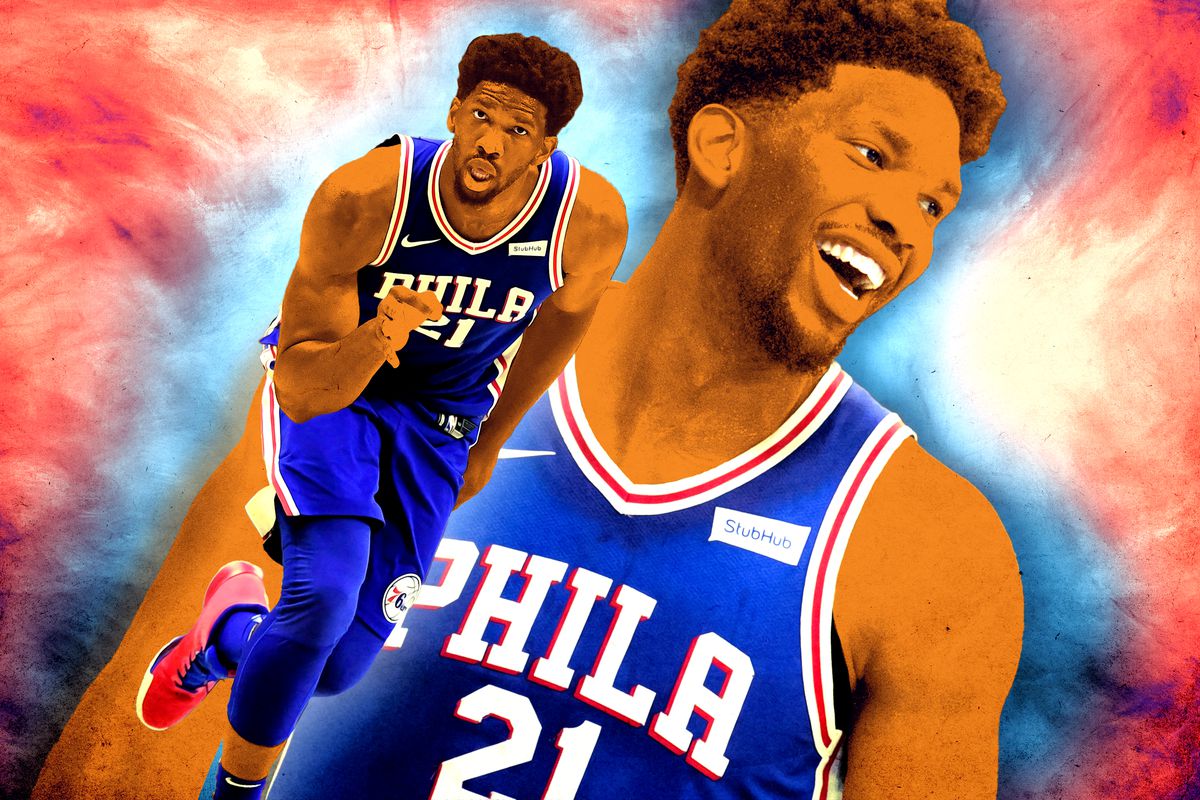(? The Ringer)
Four years ago, Joel Embiid was on the verge of being labeled a lost cause. Taken with the third overall pick, a prodigy from the prestigious basketball academies of Montverde Academy and the University of Kansas, he missed what would’ve been the first two full seasons of his career with foot injuries. Nowadays, that’s ubiquitously known as a non-issue, seeing as Embiid is in a deadlocked duel for the title as the league’s top center. Do his strong offense and DPOY-potential defense vault him high enough to claim the spot? And what are the percent odds Embiid gives a random team to win a title?
Scoring
Joel Embiid quietly remains one of the league’s top scorers. His standard profile of 23.0 points per game and 59.0 TS% don’t pop out as much as Embiid’s true scoring equity does. Due to a mere 29.5 minutes per game and Philadelphia’s -1.3 relative Pace, Embiid was actually closer to a 28 points per game scorer; during the regular season, he averaged 28.4 points per 75 possessions on +2.5 rTS%. In the Playoffs, those numbers expanded to 31.9 points per 75 on +3.9 rTS%. It’s worth noting Boston’s lack of strong interior defenders in that series, but Embiid’s scoring performances were signs of potential superstardom in the postseason.

PBPStats
Embiid’s shot chart dots the efficiency, frequency, and locations of his shooting spots from this year’s Playoffs. Evidently, his relatively broad points of attack suggest Embiid’s monster scoring in the second season wasn’t merely a result of facing poorer paint defenders. Furthermore, Boston’s strong regular-season defense (-3.6 rDRtg), given Embiid’s shot locations, was likely to limit some of his efficiency and volume, neither of which eventually were. His strong post-game was increasingly strong against the 6’8″, 245-lbs Daniel Theis as well. Embiid went to the free-throw line at an insane rate in that series, posting 15.4 free-throw attempts per 75 and 7.97 free-throw attempts per field-goal attempt. Embiid displayed strong tendencies to draw fouls in the regular season, but took it to a whole new level in the Playoffs.
It’s no secret that Philadelphia’s star center is less proficient at generating offense outside of the post. Embiid often takes ill-advised fadeaways outside of the painted, a surprising note given his converted on an adequate 41% of mid-range attempts in the regular season. He’s also prone to miss driving lanes, eliminating key opportunities for easy baskets. However, in high-effort stints, Embiid isn’t the lethargic, heavy-footed big man he appears to be at first glance. His balance, considering his size, is an indicator of strong momentum shifting.
Playmaking
Embiid’s passing is nothing to marvel over. He seldom shows flashes of proficiency in this facet in the post in which he’ll occasionally make an efficient, well-placed pass to an open interior scorer. However, he’s also prone to misreading handoff opportunities, and with screening action as a focal point of Embiid’s offense, it’s reasonable to suggest his passing hurts Philadelphia more than it helps. Embiid’s Passer Rating, a numerical estimate of passing quality, was in the 34th percentile in 2020. It’s also estimated he’s a negative-impact playmaker, contributing fewer than zero points per 100 in that manner. There are some positive indicators of Embiid’s creation. He opened more than six extra shot opportunities for his teammates every 100 possessions in the regular season; however, it’s also a figure that dipped over three points in the Playoffs. It’s unlikely Embiid will ever strengthen a good offense with his playmaking abilities.
Off-Ball
During the possessions in which Embiid isn’t “meaningfully” involved in the 76ers’ offense (~ 55% of possessions), he provides solid off-ball value. As his role as big man implies, a large part of Embiid’s off-ball repertoire is screening action up top. He’s a “dual-threat” screeners in this manner, displaying proficiency in both the interior and on the perimeter. Embiid is a strong pick-and-roll screener with a solid regime running with teammate Ben Simmons. However, Embiid’s off-ball specialty lies closer to the glass. He’s one of the game prominent offensive rebounders, grabbing 10.3% of available opportunities and 3.4 per 75 possessions. It isn’t merely a product of his 7-foot, 280-lbs frame either; Embiid is extremely active on the offensive glass. It’s arguably his strongest point of engagement and one of the areas Embiid thrives in. He’s prone to the occasional flop, wildly exaggerating contact near the basket, but his off-ball value is enough to keep afloat as an interior-specialist center. These qualities wouldn’t fit especially well alongside strong teammates.
Offensive Summary
Impact metrics are fairly split on Embiid’s offense. Play-by-play-infused metrics clearly grant the lower end of the stick in terms of offensive impact. For example, Basketball Index‘s PIPM and FiveThirtyEight‘s RAPTOR both denote Embiid’s offense as worth less than 1.1 net points per 100 possessions. However, these results are likely due to some extremities. Philadelphia’s offense improved by +2.6 points per 100 with Embiid off the floor, skewing some of these results. Box score estimates paint a fairer picture of his offense. Basketball-Reference‘s Box Plus/Minus measures Embiid’s offense at +3.7 while my own Box Plus/Minus model estimates that value at +3.4 in the regular season and the Playoffs. Embiid is not an offensive superstar, but his strong scoring is enough to propel him near the top of the pack in the major impact metrics.
Defense
Despite a high defensive valuation for Embiid, I’m fairly critical of his team defense. At times, he’s too post-oriented, opting to leave strong perimeter threats open without a paint presence to justify. Although Embiid has that strong frame that we examined earlier, he doesn’t always stay in front of his matchups. He also falls back too immensely on strong-shooting matchups, leaving several open floaters. There are also questions on his focus. Embiid seldom ball-watches, loses players who don’t have the basketball in their hands, and lacks the general defensive attentiveness to maintain consistent off-ball value.
Conversely, the qualities that make Embiid one of the league’s premier defenders are also apparent. He shows strong passing anticipation; and although he isn’t the strongest and jumping and clogging passing lanes, his reaction time counterbalances some of his slower movements. Embiid is one of the strongest paint presences in the league, having blocked 3.7% of available two-pointers in the regular season and 3.2% in the Playoffs. Paired with a sturdy stature and strong vertical movement, Embiid is one of basketball’s most dominating post defenders. Despite this paint-exclusiveness, Embiid’s value in the Playoffs remains relatively similar. Research done through Thinking Basketball suggests interior-oriented defenders lose large amounts of value in the Playoffs, while Embiid retained nearly all of his (2.3 D-PIPM in the Playoffs).
Defensive Summary
Impact metrics regularly view Embiid as one of the game’s strongest overall defenders. Box score estimates are less sensitive to his value due to a declining block rate and a stagnant steal rate; Basketball-Reference estimates his per-100 defensive impact at +1.0, Backpicks argues it’s barely over half a point, and Cryptbeam DBPM clocks that figure in at +1.4. Conversely, plus/minus hybrids value Embiid’s defense significantly higher. His three-year LA-DRAPM is a tick under +5, a clear overstatement compared to his scores in D-RAPTOR (+3.6), D-PIPM (+2.29), and DRPM (+2.00). Embiid’s post tendencies lead me to believe his defensive impact is inflated in pure impact measurements (RAPM), which is still good enough to denote Embiid as a strong All-Defensive level player.
CPA Valuation
Joel Embiid would provide a random team an increment of approximately 12.11% odds to win a championship.

Leave a Reply